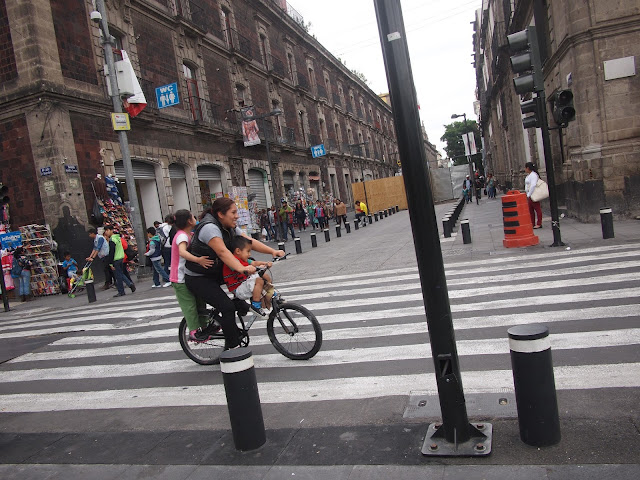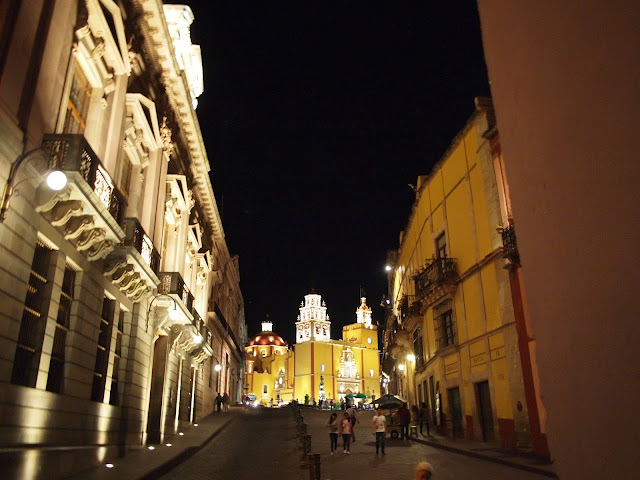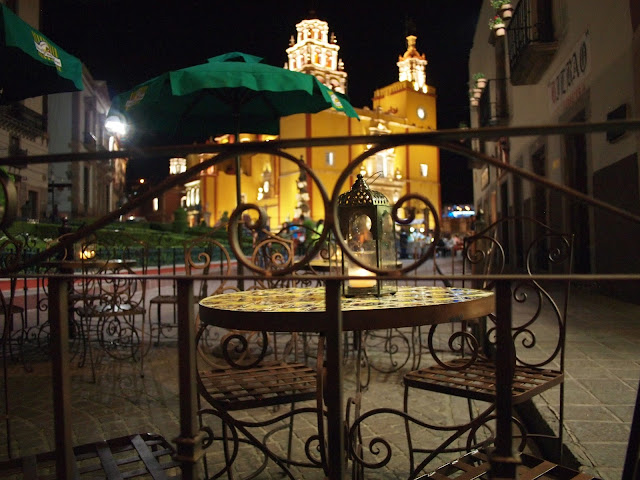 People don't go to Mexico drawn by the art of José Clemente Orozco. They are drawn by Frida Kahlo and the hugely prolific muralist Diego Rivera.
People don't go to Mexico drawn by the art of José Clemente Orozco. They are drawn by Frida Kahlo and the hugely prolific muralist Diego Rivera.I'm very pleased we found Orozco's work dominating murals in the Antiguo Colegio di San Ildefonso.
 This New York Times article provides some background to the neglect and revival of Orozco.
This New York Times article provides some background to the neglect and revival of Orozco.When you are in the street behind the Templo Mayor, Justo Serra, your attention is drawn to the ruins of the templo and when you are there on Sunday afternoon you are among the happy.
The hole on the left of this street view is the Templo Mayor,
the building on the right is the Antiguo Colegio de San Ildefonso
See it modestly on the wall, right hand side above and here below.
This is in fact historically a remarkable place. Founded by the Jesuits in the 1500s, the building itself reached its present baroque beauty by 1750, shortly before the Jesuits were expelled from Mexico and the church. San Ildefonso was not just for religious teaching but a base for wider education of students born in Mexico, both indigenous and the criolos, Spaniards born in Mexico, who were denied full citizenship in New Spain.
With the departure of the Jesuits, the college building had a century of difficult decline, as reported in Wikipedia. Its revitalisation came with the decision of President Benito Juarez to make it the National Preparatory School, a cornerstone of his drive for secular and scientific education, in 1867. The story of Benito Juarez, the only indigenous president of Mexico and reportedly the smallest-stature elected head of state in world history, is truly remarkable.
The National Preparatory School survived till 1978. It re-opened as a cultural centre in 1994.
In 1968, the school had been scene of the first deaths of students in what became a notorious crushing by government of student unrest.
We go to Mexico City in part to marvel at the murals. We see murals and say aha, this was painted here. Under patronage, as part of the government's determination to place the history of the nation in front of all. But it's more complicated than that...
Exploring the history of San Ildefonso and the murals there, in the National Preparatory College, it becomes evident that painting murals was no simple procedure, but was opposed by conservative forces, accompanied by media campaigns, uproar and violence.
This blog presents a valuable account of the fighting over the murals here. Ms Google will provide a somewhat trashy but useful translation if you access this link in Chrome.
Here are some bits of Ms Google's translation, I do commend to you that you look at the whole text. This translation leads me to suspect that as I too write at times in driven, non-simple English, her translations of my writing may also be a bit quirky. But you'll get the vigour and drift here:
The manifesto extolling the art of the people and the indigenous tradition, however repudiating bourgeois individualism masturbatory, art easel by aristocratic, acting by a monumental art, because of their public utility, its ideological propaganda good of the people, with an object of beauty for everyone.
Orozco's murals dominate the walls of this building. We sought the ceilings by David Siqueiros at higher levels but did not find them. It becomes evident, exploring Orozco, that while Diego Rivera idealised the people and the mass movements and Siqueiros was determinedly Stalinist in perspective, Orozco reflected on and painted the violence on all sides in the revolution... while savagely depicting rich people. When you walk down the middle, in my experience, you can get whacked from both sides...
...José Clemente Orozco and David Alfaro Siqueiros were violently thrown into the street by students like rabid dogs and their murals were severely beaten with sticks, stones and stabs. It was the natural reaction of a country, careerist and hypocritical middle class, formed under the confiscation of armed revolution by the national bourgeoisie, immersed in the machinery of political corruption and the servile meanness that would rarefying in the educational system, thereby forming a establisment refractory, inclined to prejudice, superstition and corporatism.
I am not a historian, I have had the honour only to visit this museum very briefly.
I present photos representing the work of Orozco and others, together with photos of the building and happy visitors on a Sunday afternoon. This museum is not free on Sunday but it's worth visiting, especially if you look into the background, as I have only achieved several weeks after visiting. Over to you, add comment if you wish.
Here is an extract from a valuable commentary on these Orozco murals from the Arab Studies Institute:
Historians tend to disagree on why Orozco chose to spare his “Maternity” scene, which was attacked by a group of Catholic women who (ironically) deemed it sacrilegious. Of the artist’s many frescoes exploring Mexico’s epic narrative (including murals in the US), his 1926 National Preparatory School panels of the Spanish conquest are perhaps most damning with overt references to the sexual violence that defined the founding of New Spain. As he resumed his commission for the institution, his approach also became starkly pensive in an additional grouping of frescoes that ushered in the pluralist nature of the muralist movement. Sharing a wall with “Maternity” is Orozco’s masterwork: “The Trench” (1926), a disconcerting yet restrained depiction of the revolution’s violence. Abandoning the airy and robust physicality of his previous “nationalist” rendering, his figures are painted with the formal temperament of early twentieth-century expressionism and the muscularity of Toltec stone carving. Against a jagged boulder, three soldiers are frozen in motion as they fall to their deaths, their nearly fixed bodies forming a tilted crucifixion.
 |
| We found no information on this work in an adjoining courtyard. |
 |
| It's Sunday and in this crowded city, a place of freedom and love. |

... and finally this below, on the ceiling above the main staircase.
Enigmatic, powerful, confronting.
Depicting as perhaps Adam and Eve, the Conquistador Herman Cortes and Malinche.
Wikipedia will introduce you to Malinche. Ambiguously the powerful, influencing or controlling the conquistadors; the betrayer of her people, among whom she was an elite figure; mother of perhaps the first mestizo child, antecedent of modern Mexico. Is Cortes restraining, imposing his will on her, while he treads on fallen Mexico? See this perspective.


































































